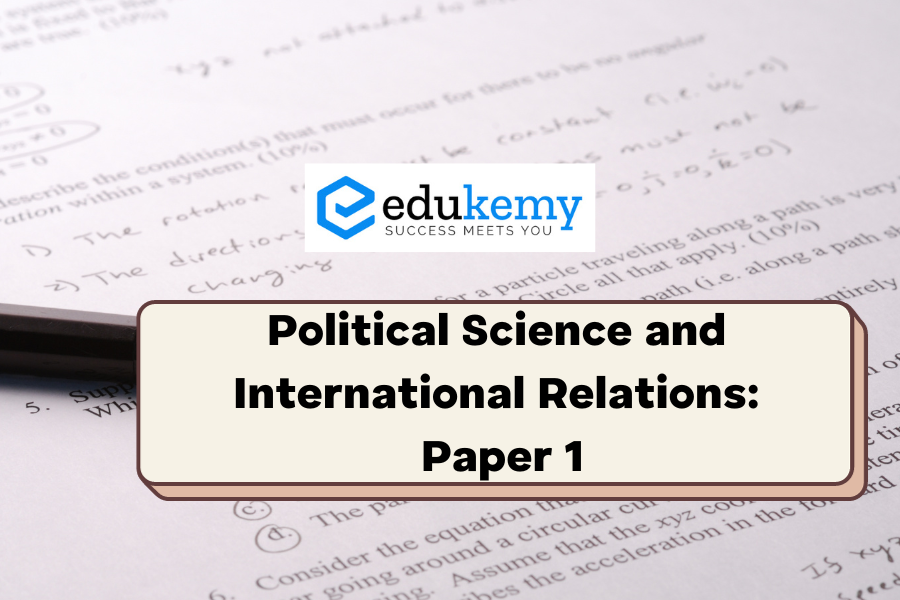
Political Science and International Relations Paper 1 encompasses a comprehensive exploration of the foundational concepts and theories that underpin the understanding of political systems and global relations. This examination typically delves into the fundamental principles of political science, including the nature of the state, governance structures, and political ideologies. Students are often required to demonstrate a nuanced comprehension of key political thinkers and their contributions to political thought. Moreover, the examination may extend its focus to the dynamics of international relations, probing into the complexities of state interactions, diplomacy, and global governance. Topics such as international organizations, conflict resolution, and the role of non-state actors in shaping global affairs may also be covered. Through this examination, students are not only expected to showcase a theoretical grasp of political concepts but also to apply these theories to analyze real-world political scenarios and international events. Ultimately, Political Science and International Relations Paper 1 serves as a crucial platform for students to develop a well-rounded understanding of the intricate tapestry of political dynamics both domestically and on the global stage.
Contents
- 1 Political Science and International Relations (PSIR): Paper 1
- 2 Section A –
- 3 SECTION ‘B’ – Answer the following in about 150 words each:
- 4 FAQs
- 4.1 Q: What is the distinction between political science and international relations?
- 4.2 Q: How do political ideologies shape government policies?
- 4.3 Q: Explain the concept of sovereignty and its relevance in the contemporary international system.
- 4.4 Q: Discuss the impact of globalization on state sovereignty.
- 4.5 Q: How do international institutions contribute to conflict resolution and peacebuilding?
- 5 In case you still have your doubts, contact us on 9811333901.
Political Science and International Relations (PSIR): Paper 1
Time: 3 Hrs
Maximum marks: 250
Instructions:
There are Eight questions divided into TWO SECTIONS. Candidates have to attempt FIVE questions in all.
Questions Nos. 1 and 5 are compulsory and out of the remaining, THREE are to be attempted by choosing at least ONE question from each section.
Section A –
1. Comment on the following in about 150 words each:
(a) Feminist Critique of the State. (10)
(b) Affirmative action (10)
(c) Equality of outcome as a political idea (10)
(d) Tools of legitimization of the state (10)
(e) J.S.Mill’s idea of women’s suffrage (10)
2.
(a) How has Rawls enriched the idea of Justice in liberalism? (20)
(b) Examine the Importance of the Behavioural Approach in political theory. What led to its decline? (15)
(c) Can there be a universal conception of human rights? Give your arguments. (15)
(a) Explain the Aristotelian view of politics. To what extent do you think it has contributed to the development of modern-day constitutional democracies? (20)
(b) “When a nation becomes devoid of arts and learning, it invites poverty.” (Sir Syed Ahmed Khan). In the light of this statement, assess the role of Sir Syed Ahmed Khan as a reformer in Modern India. (15)
(c) “Political ideology is primarily concerned with the allocation and utilization of power.” Comment. (15)
4.
(a) Do you think Buddhist traditions have lent a greater ethical foundation to ancient Indian political thought? Give your arguments. (20)
(b) Marx’s concept of ‘alienation’ is an essential part of reality in capitalism. Explain. (15)
(c) “Free and fair deliberation is the key to the foundation of democracy”. Explain. (15)
SECTION ‘B’ – Answer the following in about 150 words each:
5.
(a) The Constitution of India is a product of a historical process, rich with constitutional antecedents”. Comment. (10)
(b) The Constitutional makers faced the great task of forging a common national identity in the face of unparallel social and cultural diversity in India.” Comment. (10)
(c) Mention the founding principles that define India’s Constitution. (10)
(d) Analyse the Marxist perspective of the nature of the Indian National Movement. (10)
(e) Underline the significance of the first constitutional amendment. (10)
6.
(a) “Constitutionally reconciling the Fundamental Rights with the Directive Principles of the State Policy has led to frequent amendments of the constitution and judicial interventions.” Comment. (20)
(b) The role of the President of India becomes more significant during a minority government and a coalition government. Explain. (15)
(c) Do you think that despite having significant limitations the Panchayati Raj Institutions have strengthened the process of democratic decentralization? Give your views. (15)
7.
(a) The Indian party system is shaped by a complex interaction of the country’s federal structure, electoral system, and social cleavages”. Explain. (20)
(b) Do you think that there has been a gradual shift in the basis on which the demands for the creation of new states have been raised in different regions of India? Explain. (15)
(c) What explains India’s modest improvements in social development outcomes even as the rate of growth has accelerated since the initiation of economic reforms? (15)
8.
(a) “The success of electoral democracy can partly be attributed to the status and role of the Election Commission of India.” Explain (20)
(b) Examine the evolution of the jurisdiction of the Supreme Court of India as a constitutional court. (15)
(c) Explain how caste as a social category is also becoming a political category in the democratic politics of India. (15)
FAQs
Q: What is the distinction between political science and international relations?
Answer: Political science primarily focuses on the study of government structures, political systems, and domestic politics, while international relations delves into the interactions between states, international organizations, and global issues. While both fields are interconnected, political science tends to emphasize the national level, whereas international relations explores the global arena.
Q: How do political ideologies shape government policies?
Answer: Political ideologies serve as frameworks of ideas and values that influence the formulation of government policies. Whether liberal, conservative, socialist, or other ideologies, they guide policymakers in determining the role of the state, economic policies, and the distribution of resources. Understanding the relationship between political ideologies and policy decisions is crucial in analyzing governance structures.
Q: Explain the concept of sovereignty and its relevance in the contemporary international system.
Answer: Sovereignty refers to the supreme authority of a state to govern itself without external interference. In the contemporary international system, the concept of sovereignty is both challenged and reinforced. While globalization and international organizations promote interdependence, states still assert their sovereignty in areas such as national security and internal affairs. This tension between global cooperation and state autonomy is a key dynamic in today’s international relations.
Q: Discuss the impact of globalization on state sovereignty.
Answer: Globalization, characterized by increased interconnectedness in economic, political, and cultural domains, has profound implications for state sovereignty. The movement of capital, information, and people across borders challenges traditional notions of state control. States must navigate the tension between participating in the global economy and maintaining control over their internal affairs. This dynamic is a central theme in contemporary discussions within international relations.
Q: How do international institutions contribute to conflict resolution and peacebuilding?
Answer: International institutions, such as the United Nations, play a vital role in conflict resolution and peacebuilding. They provide platforms for diplomatic negotiations, peacekeeping missions, and the establishment of norms and rules to guide state behavior. Analyzing the effectiveness of these institutions requires an understanding of their structures, functions, and the challenges they face in addressing conflicts and promoting global peace and security.
In case you still have your doubts, contact us on 9811333901.
For UPSC Prelims Resources, Click here
For Daily Updates and Study Material:
Join our Telegram Channel – Edukemy for IAS
- 1. Learn through Videos – here
- 2. Be Exam Ready by Practicing Daily MCQs – here
- 3. Daily Newsletter – Get all your Current Affairs Covered – here
- 4. Mains Answer Writing Practice – here

